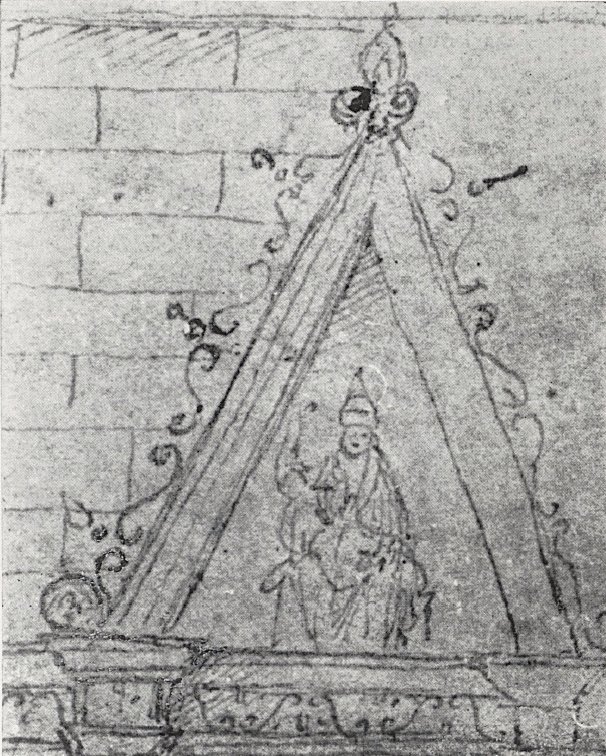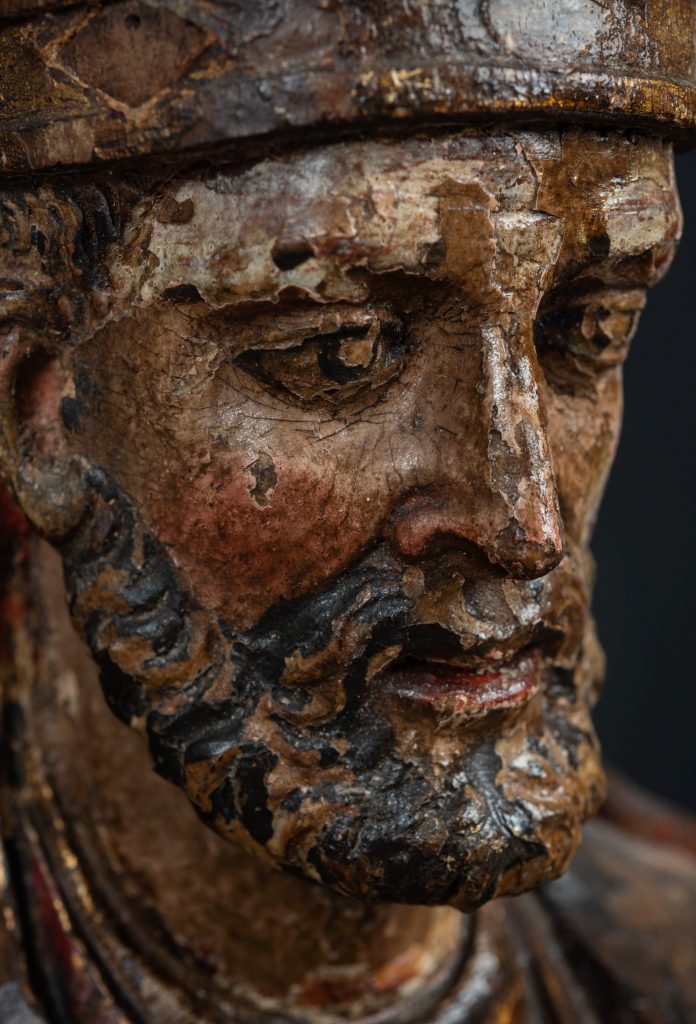Source: Rothschild Album I, fol. 12, Paris, Musée du Louvre, Département des arts graphiciques
Dating: c. 1506–1507
Format: Architectural sketch with figures

Description of the image content
The sheet shows an architecturally structured façade plan with a figurative design at the center of a pediment. A frontal male figure sits on a throne within a triangular aedicule. The figure is large, centrally positioned, and highlighted by a striking headdress (presumably a miter or tiara). Particularly striking is a darkly hatched area in the lower face, which stands out clearly from the surroundings – a visual suggestion of a beard.

Attribution, dating and context
The drawing is related to Michelangelo’s work for Pope Julius II, particularly the lost bronze statue that was installed above the main portal of the Basilica of San Petronio in Bologna from 1506 until its destruction in 1511. The dating to around 1506/07 is confirmed by stylistic features and the planning phase of the façade.
Norbert Huse writes:
“Nothing of it remains. […] To my knowledge, no subsequent drawing has surfaced so far.”
(Huse, “Ein Bilddokument zu Michelangelo’s Julius II. in Bologna,” Miszellen, pp. 355–358)
This drawing would thus be a potential visual echo of the lost statue – or part of the design context of its architectural setting.
Iconographic Analysis: Identification of the Figure
a) Papal Iconography
- The depicted figure exhibits characteristics of papal representation: central placement, enthroned position, representative headdress, and a blessing or judging gesture.
- The architectural context (portal zone of a church) suggests a public, sovereign figure – not an allegorical or anonymous motif.
b) Reference to Julius II.
- The drawing was created at the same time as Michelangelo was commissioned to create the statue of Julius II in Bologna.
- At the time of the drawing, Julius II had already been Pope since 1503, had conquered the city of Bologna in 1506, and was considered the dominant power figure in central Italy.
- A depiction of San Petronio as a local saint would be possible, but not with a miter, enthroned posture, and beard.
The figure can therefore be interpreted with a high degree of probability as Julius II, especially in the architectural iconographic context of the main portal of San Petronio.
The beard – an iconographic clue with an open chronology
a) Depiction
- The facial area is drawn darker, especially in the area of the chin and cheeks.
- This hatching is not due to the lighting, but rather suggests a conscious physiognomic characterization: a beard is likely intended.
b) Historical Context
- The standard narrative in art history dates Julius’s beard to June 1511 to March 1512 – as a sign of papal penitence after the reconquest of Bologna from the French.
- This dating is based primarily on the impact of Raphael’s bearded portrait of Julius II in the National Gallery in London.
However:
There is no reliable evidence that Julius II was consistently clean-shaven before 1511.
The phrase “grew his beard” in contemporary texts refers to an attribution of meaning, not to the first existence of a beard.
This document could thus attest to an earlier phase of bearded representations of Julius II – whether from a real appearance or as an iconographic attribution of “Old Testament authority” (similar to images of prophets of the time).
The beard is therefore not a contradiction – it is a reference. A staging of power, repentance, and legitimacy. Not a saint’s story, but political imagery in the Renaissance.
Artistic and Political Significance
The drawing is more than an architectural study: It demonstrates the strategic integration of personalized representation into urban space.
A bearded Julius II above the portal of San Petronio would be:
- a sign of spiritual sovereignty over the city
- an allusion to the tradition of Old Testament leadership figures (Moses, Aaron)
- a conscious distancing from the Borgia papacy of Alexander VI, which embodied luxury and worldliness
He wore the beard not to mourn – but to rule
The enthroned, bearded figure on page 12 of the Rothschild Album is most likely to be interpreted as Pope Julius II. The beard depiction is historically plausible and artistically significant – either as an expression of an earlier, previously overlooked phase of bearded representation or as an iconographic symbol of authority and ascetic self-restraint, as can also be found in Michelangelo’s sculptural language.
This would make this sheet:
- the earliest surviving pictorial evidence of a bearded depiction of Julius II,
- a possible visual precursor to the lost statue,
- and an important building block for the reconstruction of Michelangelo’s political imagery.




